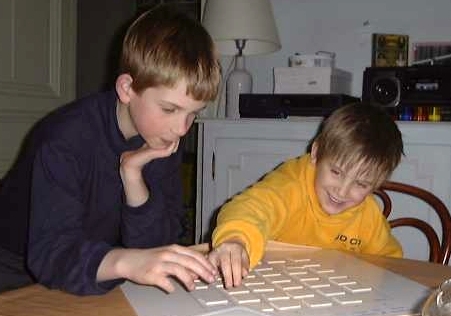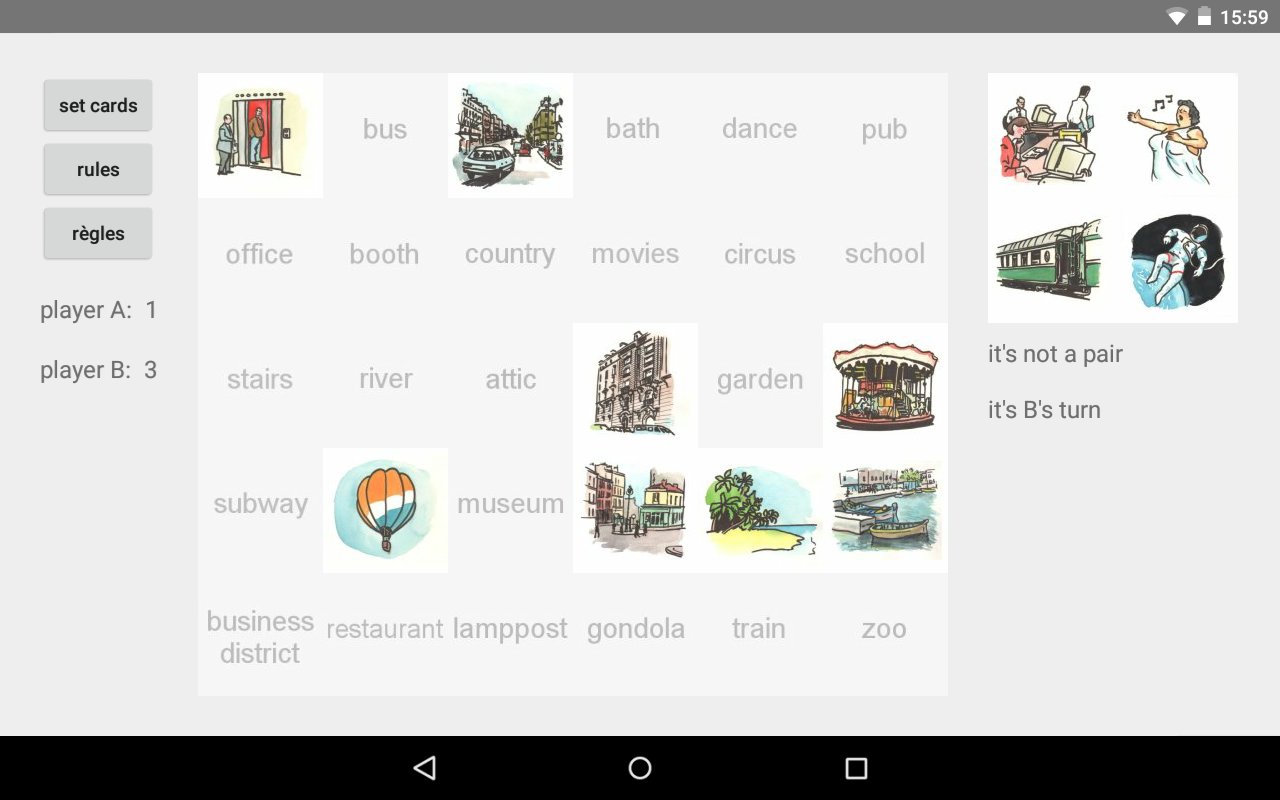 |
|

Télécharger l'appli sur la Google Play Store ou sur notre site lapasserelle car il semble que les responsables de Google Play soient devenus complètement givrés et vident leur "store" de toutes les applis développées gratuitement par des petits développeurs indépendants. |
Vous pouvez naturellement continuer à jouer sur le Net ci-dessous.
|
For an easier game, with children, you may print the board |
The cards are face down but you can "see through" them the cells names. |
|
|
|
Developers : Théophile & André |
|||||||||||||||||||||||||||||||||||||||||||||||||
|
|
||||||||||||||||||||||||||||||||||||||||||||||||||
|
Notes:
Description and rules of the game"Memory and Imagination" is a board game with cards. Its purpose is to develop the memory and imagination of the players. In particular it stimulates and develops the right brain.The main idea is to use the associative capabilities of the players (i.e. the ability to imagine some situation linking two items with no natural relationship, for instance "Singer" and "Hot air balloon") to sustain memory. In the present version, it is played between two players, on a computer. And thanks to the magic of virtual worlds, one can see through the cards the names of the cells. Rules:At the outset, 15 pairs of cards are shuffled, and put face down on the 30 cells of the board. The objective for each player is to uncover and remove the maximum number of pairs. The board is there to help sustain memory via associations between the pictures in the cells, and pictures on the cards on the cells.Players play in turn. The first player selects and turns up two cards. If its a pair, its for him or her, and he or she plays again. Otherwise, after everybody has seen the cards and the cells they come from, he puts them back, face hidden, on their cells. And its the second player's turn. The second player turns up two cards. If, after he has turned up his first card, he sees that it corresponds to another one already seen, and he remembers where it was, he will be able to win a pair. If what he turns up is not a pair, he puts the cards back face hidden, and it's player one's turn again. The game ends when no card is left. The winner is the player who has won the largest number of pairs. What makes the game new and interesting:"Memory and Imagination" stimulates and develops the right brain (something few games do, as they are more often related to left brain faculties).With the help of associations that players will have constructed in their heads between the cards and cells already seen, they will be able to find pairs more easily. Thus, if a few turns ago, the players saw the card "Fireman" in the cell "Dance", the current player, if he turns up the other "Fireman" card, may remember that he imagined in his mind a fireman standing by the entrance of a ball room for security. Experience with "Memory and Imagination" shows that it leads to lively games. It is different from the standard Memory game, where only spatial memory is solicited. It requires making links between things unusually linked, for instance: "Attic" and "Fairy", or "Swimming pool" and "Clairvoyant", etc. The players can have fun comparing the links they created in their minds. Experience also shows that, whereas kids are usually better than adults at the classical memory game, with "Memory and Imagination" kids and adults are again on par.
Description et règle du jeu :"Mémoire et imagination" est un jeu de société à plateau et cartes. Son but est de développer la mémoire et l'imagination des joueurs. Il stimule et développe en particulier le cerveau droit. Dans la version proposée ci-dessus, il se joue à deux joueurs. Règle :Au début du jeu, 15 paires de cartes sont mélangées et posées face cachée, sur les 30 cases du plateau (pour "mémoire", c'est la magie de l'informatique, les noms des cases du plateau apparaissent à travers les cartes).Il faut retrouver les paires de cartes, et les retirer du plateau à mesure quelles sont retrouvées. Les images des cases du plateau servent à l'imagination associative, qui elle-même sert à soutenir la mémoire. Les joueurs jouent à tour de rôle. Le premier joueur retourne, en cliquant sur chacune d'entre elles, deux cartes qu'il a choisies où il veut. L'autre joueur voit les dessins et les noms des deux cartes, et les dessins et les noms des deux cases correspondantes. Si c'est une paire, le premier joueur garde cette paire, et rejoue. Sinon les cartes sont remises, face cachée, où elles étaient. Le deuxième joueur, maintenant, retourne deux cartes choisies où il veut. Si c'est une paire il la garde et rejoue, sinon les cartes sont remises face cachée, et c'est de nouveau le tour du premier joueur, etc. Le jeu est terminé quand il n'y a plus de cartes sur le plateau. Le gagnant est celui qui a ramassé le plus de paires. Intérêt du jeu :Le jeu Mémoire et Imagination permet de stimuler et développer le cerveau droit. Grâce aux associations que les joueurs feront dans leur tête entre les cartes qu'on a retournées pour les vérifier, et les images des cases correspondantes, ils pourront retrouver plus facilement les paires.
Copyright: André Cabannes, 1998 |
